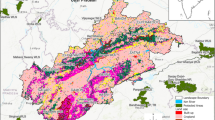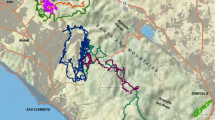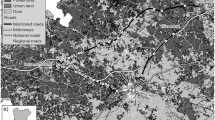Abstract
Context
Connectivity models for animal movement frequently use resistance surfaces, but rarely incorporate actual movement data and multiple scale drivers of landscape resistance.
Objectives
Using GPS data, we developed a multi-scale model of landscape resistance for tiger (Panthera tigris) dispersal in central India and evaluated the performance, interpretation and predictions against single scale models.
Methods
Six dispersing tiger paths were subjected to a path level analysis with conditional logistic regression to parameterize a resistance surface. We evaluated for 21 scales of available habitat and selected the best scale for each variable. We derived a scale-optimized multivariate path selection function and predicted landscape resistance across the landscape.
Results
The tigers preferred to move along areas with forest cover at relatively high elevations along the ridges with rugged topography at broad scale, while avoiding areas with agriculture-village matrix at fine scale. We found that the scale that was most supported by Akaike’s information criterion was not always the scale that maximized the magnitude (effect size) of the relationship. Further, the multi-scale optimized model differed substantially from the single scale models in terms of variable importance, magnitude of coefficients and predictions of connectivity.
Conclusions
Our results demonstrate that the variables in landscape resistance models produce markedly different predictions of population connectivity depending on the scales of analyses and interpretation. Thus, scale optimization in parameterization is critical for appropriate inferences and sound management strategies.








Similar content being viewed by others
References
Blaszczynski JS (1997) Landform characterization with geographic information systems. Photogramm Eng Remote Sens 63(2):183–191
Burnham KP, Anderson DR (2002) Model selection and multimodel inference: a practical information-theoretic approach, 2nd edn. Springer, New York
Castillo JA, Epps CW, Davis AR, Cushman SA (2014) Landscape effects on gene flow for a climate-sensitive montane species, the American pika. Mol Ecol 23(4):843–856
Compton BW, McGarigal K, Cushman SA, Gamble LR (2007) A resistant-kernel model of connectivity for amphibians that breed in vernal pools. Conserv Biol 21(3):788–799
Compton BW, Rhymer JM, McCollough M (2002) Habitat selection by wood turtles (Clemmys insculpta): an application of paired logistic regression. Ecology 83(3):833–843
Coulon A, Morellet N, Goulard M, Cargnelutti B, Angibault JM, Hewison AM (2008) Inferring the effects of landscape structure on roe deer (Capreolus capreolus) movements using a step selection function. Landscape Ecol 23(5):603–614
Craiu RV, Duchesne T, Fortin D (2008) Inference methods for the conditional logistic regression model with longitudinal data. Biom J 50(1):109
Cushman SA, Lewis JS (2010) Movement behavior explains genetic differentiation in American black bears. Landscape Ecol 25(10):1613–1625
Cushman SA, Chase M, Griffin C (2005) Elephants in space and time. Oikos 109(2):331–341
Cushman SA, McKelvey KS, Hayden J, Schwartz MK (2006) Gene flow in complex landscapes: testing multiple hypotheses with causal modeling. Am Nat 168(4):486–499
Cushman SA, Chase M, Griffin C (2010) Mapping landscape resistance to identify corridors and barriers for elephant movement in southern Africa. In: Cushman SA, Heutmann S (eds) Spatial complexity, informatics, and wildlife conservation. Springer, Tokyo, Berlin, Heidelberg, New York, pp 349–367
Cushman SA, Landguth EL, Flather CH (2012) Evaluating the sufficiency of protected lands for maintaining wildlife population connectivity in the US northern Rocky Mountains. Divers Distrib 18(9):873–884
Cushman SA, Lewis JS, Landguth EL (2014) Why did the bear cross the road? Comparing the performance of multiple resistance surfaces and connectivity modeling methods. Diversity 6(4):844–854
Elliot NB, Cushman SA, Macdonald DW, Loverige AJ (2014) The devil is in the dispersers: predictions of landscape connectivity change with demography. J Appl Ecol 51(5):1169–1178
ESRI (2010) ArcGIS desktop: release 10. Environmental Systems Research Institute, Redlands
Evans JS, Oakleaf J, Cushman SA, Theobald D (2014). An ArcGIS toolbox for surface gradient and geomorphometric modeling, version 2.0-0. http://evansmurphy.wix.com/evansspatial. Accessed 2 Dec 2014
Fernandes A (2012) How coal mining is trashing tigerland. Greenpeace, Bengaluru, p 115. http://www.greenpeace.org/india/Global/india/report/How-Coal-mining-is-Trashing-Tigerland.pdf. Accessed 4 July 2015
Forest Survey of India (2011) India state of forest report 2011. Forest Survey of India, Ministry of Environment, Forest & Climate Change, Government of India, Dehradun
Fortin D, Beyer HL, Boyce MS, Smith DW, Duchesne T, Mao JS (2005) Wolves influence elk movements: behavior shapes a trophic cascade in Yellowstone National Park. Ecology 86(5):1320–1330
Galpern P, Manseau M (2013) Modelling the influence of landscape connectivity on animal distribution: a functional grain approach. Ecography 36(9):1004–1016
Goodrich JM, Kerley LL, Smirnov EN, Miquelle DG, McDonald L, Quigley HB, Hornocker MB, McDonald T (2008) Survival rates and causes of mortality of Amur tigers on and near the Sikhote-Alin Biosphere Zapovednik. J Zool 276(4):323–329
Goodrich J, Lynam A, Miquelle D, Wibisono H, Kawanishi K, Pattanavibool A, Htun S, Tempa T, Karki J, Jhala Y, Karanth U (2015) Panthera tigris. The IUCN red list of threatened species 2015: e.T15955A50659951. 10.2305/IUCN.UK.2015-2.RLTS.T15955A50659951.en. Accessed 08 Feb 2016
Gour DS, Bhagavatula J, Bhavanishankar M, Reddy PA, Gupta JA, Sarkar MS, Shaik MH, Segu H, Ravinder G, Shivaji S (2013) Philopatry and dispersal patterns in tiger (Panthera tigris). PloS One 8(7):e66956
Grand J, Buonaccorsi J, Cushman SA, Griffin CR, Neel MC (2004) A multiscale landscape approach to predicting bird and moth rarity hotspots in a threatened pitch pine—scrub oak community. Conserv Biol 18(4):1063–1077
Gurung TR, Bousquet F, Trébuil G (2006) Companion modeling, conflict resolution, and institution building: sharing irrigation water in the Lingmuteychu Watershed, Bhutan. Ecol Soc 11(2):36
Hanski I, Gilpin M (eds) (1997) Metapopulation biology: ecology, genetics and evolution. Academic Press, London
Hegel TM, Cushman SA, Evans J, Huettmann F (2010) Current state of the art for statistical modelling of species distributions. In: Cushman SA, Heutmann S (eds) Spatial complexity, informatics, and wildlife conservation. Springer, Berlin, pp 273–311
Hilty JA, Lidicker WZ Jr, Merenlender A (2006) Corridor ecology: the science and practice of linking landscapes for biodiversity conservation. Island Press, Washington, DC
Jarvis A, Reuter HI, Nelson A, Guevara E (2006) CGIAR-CSI SRTM 90 m database, version 4
Joshi A, Vaidyanathan S, Mondol S, Edgaonkar A, Ramakrishnan U (2013) Connectivity of tiger (Panthera tigris) populations in the human-influenced forest mosaic of central India. PloS One 8(11):e77980. doi:10.1371/journal.pone.0077980
Landguth EL, Hand BK, Glassy J, Cushman SA, Sawaya MA (2012) UNICOR: a species connectivity and corridor network simulator. Ecography 35(1):9–14
Martin AE, Fahrig L (2012) Measuring and selecting scales of effect for landscape predictors in species habitat models. Ecol Appl 22:2277–2292
Mateo Sánchez MC, Cushman SA, Saura S (2013) Scale dependence in habitat selection: the case of the endangered brown bear (Ursus arctos) in the Cantabrian Range (NW Spain). Int J Geogr Inf Sci. doi:10.1080/13658816.2013.776684
Mateo Sánchez MC, Cushman SA, Saura S (2014) Scale dependence in habitat selection: the case of the endangered brown bear (Ursus arctos) in the Cantabrian Range (NW Spain). Int J Geogr Inf Sci 28(8):1531–1546
Mateo-Sánchez MC, Balkenhol N, Cushman S, Pérez T, Domínguez A, Saura S (2015) A comparative framework to infer landscape effects on population genetic structure: are habitat suitability models effective in explaining gene flow? Landscape Ecol 30(8):1405–1420
McGarigal K, Cushman SA, Neel MC, Ene E (2002) FRAGSTATS: spatial pattern analysis program for categorical maps. http://www.umass.edu/landeco/research/fragstats/fragstats.html
McGarigal K, Cushman SA, Ene E (2012) FRAGSTATS v4: spatial pattern analysis program for categorical and continuous maps. 2012. Computer software program produced by the authors at the University of Massachusetts, Amherst. http://www.umass.edu/landeco/research/fragstats/fragstats.html
Meher-Homji VM (1990) Vegetation types of India in relation to environmental conditions. In: Daniel JC, Serrao JS (eds) Conservation in developing countries: problems and prospects. Oxford University Press, Bombay, pp 95–110
Morales JM, Ellner SP (2002) Scaling up animal movements in heterogeneous landscapes: the importance of behavior. Ecology 83(8):2240–2247
R Core Team (2012) R: a language and environment for statistical computing. R Foundation for Statistical Computing, Vienna. ISBN 3-900051-07-0. http://www.R-project.org/
Reddy PA, Gour DS, Bhavanishankar M, Jaggi K, Hussain SM, Harika K, Shivaji S (2012) Genetic evidence of tiger population structure and migration within an isolated and fragmented landscape in northwest India. PloS One 7(1):e29827. doi:10.1371/journal.pone.0029827
Reding DM, Bronikowski AM, Johnson WE, Clark WR (2012) Pleistocene and ecological effects on continental-scale genetic differentiation in the bobcat (Lynx rufus). Mol Ecol 21(12):3078–3093
Reding DM, Cushman SA, Gosselink TE, Clark WR (2013) Linking movement behavior and fine-scale genetic structure to model landscape connectivity for bobcats (Lynx rufus). Landscape Ecol 28(3):471–486
Riley SJ, DeGloria SD, Elliot R (1999) A terrain ruggedness index that quantifies topographic heterogeneity. Intermt J Sci 5(1–4):23–27
Sawyer SC, Epps CW, Brashares JS (2011) Placing linkages among fragmented habitats: do least-cost models reflect how animals use landscapes? J Appl Ecol 48(3):668–678
Schaller GB (2009) The deer and the tiger. University of Chicago Press, Chicago
Seidensticker J (2015) Biodiversity resilience in the Central Indian Highlands is contingent on maintaining and recovering landscape connectivity: the tiger as a case study. Reg Environ Change. doi:10.1007/s10113-015-0846-6
Seidensticker J, Christie S, Jackson P (1999) Riding the tiger: tiger conservation in human dominated landscapes. Cambridge University Press, Cambridge
Sharma S, Dutta T, Maldonado JE, Wood TC, Panwar HS, Seidensticker J (2013) Forest corridors maintain historical gene flow in a tiger metapopulation in the highlands of central India. Proc R Soc Lond 280(1767):20131506
Shirk AJ, Wallin DO, Cushman SA, Rice CG, Warheit KI (2010) Inferring landscape effects on gene flow: a new model selection framework. Mol Ecol 19(17):3603–3619
Shirk AJ, Raphael MG, Cushman SA (2014) Spatiotemporal variation in resource selection: insights from the American marten (Martes americana). Ecol Appl 24(6):1434–1444
Singh V, Murthy RS, Pofali RM, Saxena RK (1983) Terrain analysis of Panna District, Bundelkhand, Madhya Pradesh, using LANDSAT imagery. J Indian Soc of Photo-Interpret Remote Sens 11(1):43–48
Singh R, Qureshi Q, Sankar K, Krausman PR, Goyal SP (2013) Use of camera traps to determine dispersal of tigers in semi-arid landscape, western India. J Arid Environ 98:105–108
Singh SK, Sharma V, Mishra S, Pandey P, Kumar VP, Goyal SP (2015) Understanding tiger–human conflict in Corbett Tiger Reserve (CTR) India: based on the genetic analysis. Wildl Biol Pract 11(1):1–11
Smith JLD (1993) The role of dispersal in structuring the Chitwan tiger population. Behaviour 124:165–195
Spear SF, Balkenhol N, Fortin MJ, McRae BH, Scribner KIM (2010) Use of resistance surfaces for landscape genetic studies: considerations for parameterization and analysis. Mol Ecol 19(17):3576–3591
Stephens DW, Krebs JR (1986) Foraging theory. Princeton University Press, Princeton
Thompson CM, Mcgarigal K (2002) The influence of research scale on bald eagle habitat selection along the lower Hudson River, New York (USA). Landscape Ecol 17(6):569–586
Wasserman TN, Cushman SA, Schwartz MK, Wallin DO (2010) Spatial scaling and multi-model inference in landscape genetics: martes Americana in Northern Idaho. Landscape Ecol 25(10):1601–1612
Wasserman TN, Cushman SA, Wallin DO, Hayden J (2012) Multi scale habitat relationships of Martes americana in Northern Idaho, USA. Research paper RMRS-RP-94. Department of Agriculture, Forest Service, Rocky Mountain Research Station, Fort Collins
Wiens JA (1989) Spatial scaling in ecology. Funct Ecol 3(4):385–397
Wikramanayake ED, Dinerstein E, Robinson JG, Karanth KU, Rabinowitz A, Olson D, Mathew T, Hedao P, Connor M, Hemley G, Bolze D (1999) Where can tigers live in the future? A framework for identifying high-priority areas for the conservation of tigers in the wild. In: Seidensticker J, Christie S, Jackson P (eds) Riding the tiger: tiger conservation in human-dominated landscapes. Cambridge University Press, Cambridge, pp 256–272
Wildlife Conservation Society (WCS), Center for International Earth Science Information Network (CIESIN) Columbia University (2005) Last of the wild project, version 2, 2005 (LWP-2): global human footprint dataset (geographic). NASA Socioeconomic Data and Applications Center (SEDAC). Palisades, NY. doi: 10.7927/H4M61H5F
Young AG, Clarke GM (2000) Genetics, demography and viability of fragmented populations, vol 4. Cambridge University Press, Cambridge
Yumnam B, Jhala YV, Qureshi Q, Maldonado JE, Gopal R, Saini S, Srinivas Y, Fleischer RC (2014) Prioritizing tiger conservation through landscape genetics and habitat linkages. PloS One. doi:10.1371/journal.pone.0111207
Zeller KA, McGarigal K, Whiteley AR (2012) Estimating landscape resistance to movement: a review. Landscape Ecol 27(6):777–797
Zeller KA, Rabinowitz A, Salom-Perez R, Quigley H (2013) The jaguar corridor initiative: a range-wide conservation strategy. In: Ruiz-Garcia M, Shostell JM (eds) Molecular population genetics, evolutionary biology, and biological conservation of neotropical carnivores. Nova Science Publishers, New York, pp 629–658
Zeller KA, McGarigal K, Beier P, Cushman SA, Vickers TW, Boyce WM (2014) Sensitivity of landscape resistance estimates based on point selection functions to scale and behavioral state: pumas as a case study. Landscape Ecol 29(3):541–557
Zeller KA, McGarigal K, Cushman SA, Beier P, Vickers TW, Boyce WM (2015) Using step and path selection functions for estimating resistance to movement: pumas as a case study. Landscape Ecol. doi:10.1007/s10980-015-0301-6
Acknowledgments
We thank Madhya Pradesh Forest Department, National Tiger Conservation Authority and Wildlife Institute of India for the opportunity to undertake this study. We are grateful to Dr, H.S. Pabla, Dr. Rajesh Gopal, Shri. Narendra Kumar, Shri. Dharmendra Shukla, Dr. Suhas Kumar, Shri. R. Sreenivasa Murthy, Shri. P.R. Sinha, Dr. V.B. Mathur, Shri. S.P. Yadav, Shri. Vikram Parihar, Dr. Parag Nigam and Dr. Sanjeev Gupta for support and encouragement. All researchers, volunteers and assistants (Ravi Parmar, Devi Pryadarshini, J Yogesh, Raja Raj Tilak, Rahul K, Arun Kumar, Sunil Kumar, Sunal K Roamin, Pappu Yadav, Md Rauf, Darshan Singh and Manoj Yadav), and field staff of provided support for data collection.
Author information
Authors and Affiliations
Corresponding author
Electronic supplementary material
Below is the link to the electronic supplementary material.
Rights and permissions
About this article
Cite this article
Krishnamurthy, R., Cushman, S.A., Sarkar, M.S. et al. Multi-scale prediction of landscape resistance for tiger dispersal in central India. Landscape Ecol 31, 1355–1368 (2016). https://doi.org/10.1007/s10980-016-0363-0
Received:
Accepted:
Published:
Issue Date:
DOI: https://doi.org/10.1007/s10980-016-0363-0




